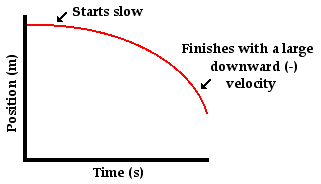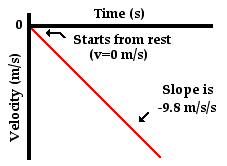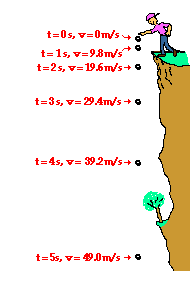Introduction to Free Fall Motion
In air, a coin falls faster than a piece of paper. However, in a vacuum, they fall at the same rate. The difference, in air, is due to air resistance having a greater effect in light bodies than on heavier bodies. Thus, free fall is the motion of an object under the influence of gravity alone, neglecting air resistance.
For a long time, people believed that heavy bodies fall faster than light bodies, which was according to Aristotle . But according to legend, during the sixteenth century, Galileo Galilei disproved this by dropping a small iron and a large cannon ball from the Leaning Tower of Pisa. To the surprise of the onlookers, two balls almost reached the ground at the same time. (Physics at Work 1 by P. K. Tao, 1992)
Representing Free Fall by Graphs
A position versus time graph for a free-falling object is shown below.

Observe that the line on the graph curves. A curved line on a position versus time graph signifies an accelerated motion. Since a free-falling object is undergoing an acceleration (g = 9.8 m/s/s), it would be expected that its position-time graph would be curved. A further look at the position-time graph reveals that the object starts with a small velocity (slow) and finishes with a large velocity (fast). Since the slope of any position vs. time graph is the velocity of the object, the small initial slope indicates a small initial velocity and the large final slope indicates a large final velocity. Finally, the negative slope of the line indicates a negative (i.e., downward) velocity.
A velocity versus time graph for a free-falling object is shown below.

Observe that the line on the graph is a straight, diagonal line. As learned earlier, a diagonal line on a velocity versus time graph signifies an accelerated motion. Since a free-falling object is undergoing an acceleration (g = 9.8 m/s/s, downward), it would be expected that its velocity-time graph would be diagonal. A further look at the velocity-time graph reveals that the object starts with a zero velocity (as read from the graph) and finishes with a large, negative velocity; that is, the object is moving in the negative direction and speeding up. An object that is moving in the negative direction and speeding up is said to have a negative acceleration . Since the slope of any velocity versus time graph is the acceleration of the object , the constant, negative slope indicates a constant, negative acceleration. This analysis of the slope on the graph is consistent with the motion of a free-falling object - an object moving with a constant acceleration of 9.8 m/s/s in the downward direction.
(http://www.physicsclassroom.com/Class/1DKin/U1L5c.cfm)Diagrams on Free Falling Bodies
The Four Kinematic Equations on Free Fall
The symbols in the given equations have a specific meaning:
the symbol Δy stands for the displacement;
the symbol t stands for the time;
the symbol g stands for the gravity= 9.8 m/s/s of the object;
the symbol vi stands for the initial velocity value;
and the symbol vf stands for the final velocity.
 |
| More likely 5% related to free fall |





No comments:
Post a Comment